





By Clay Masters
owered flags waved above the Minnesota Capitol as hundreds gathered Wednesday night for a candlelight vigil in honor of former Minnesota House Speaker Melissa Hortman and husband Mark. They were killed early Saturday by a gunman targeting Democratic lawmakers.
The vigil is the first of a series of public remembrances to the Hortmans before they are laid to rest. It drew people of various political backgrounds and stature and included those who knew the Hortmans personally or through her work. There were those who called the 11-term legislator a friend, colleague, ally, or a combination of those.
The crowd stood shoulder to shoulder in front of a memorial of flowers, flags, handwritten notes and other mementos to Hortman.
Lynne Billing of St. Paul was
in attendance. Although she did not know Hortman personally, she said she felt the weight of the loss.
“I knew she was special and I knew she really cared about people,” she said. “It’s just a huge, huge loss and I’m just here to say I’m going to miss her.”
A large blanket was spread on the ground where people wrote messages in marker.
“Melissa was a true model of humility. She didn’t do this work to boost her own ego, further her political career or garner fame and glory. She did it to improve people’s lives,” was the message a person named Marissa left, signed with a gold heart.
A brass band ensemble played “Amazing Grace.”
A Native American drum circle formed that was followed by a string quartet.
Many in attendance stood with crossed arms and bowed heads. Some wiped away tears.
■ See CANDELIGHT on page 5

For Black Collective Foundation the new philanthropy is community-driven
By Jasmine McBride Associate Editor
he Black Collective Foundation MN marked Juneteenth with its signature event, Rooted & Radiant, a vibrant brunch and social gathering that drew over 200 Black leaders, creatives, and philanthropic partners to the Glass House in Minneapolis on Thursday, June 19.
The annual event, now in its fifth year, served as a joyful yet grounded celebration of Black brilliance, resilience, and community power. Hosted on Freedom Day, it also offered a space for collective reflection amid a heavy national mood.
“Some of our spirits may be high and some of our spirits may be low, but our spirits are together, and that’s what matters,” said Lulete Mola, cofounder and president of the Black Collective Foundation MN. “We decided to do this on Juneteenth to commemo-

rate that this is Independence Day. This is Freedom Day.”
The brunch was part celebration and part call to action, centered on the Foundation’s
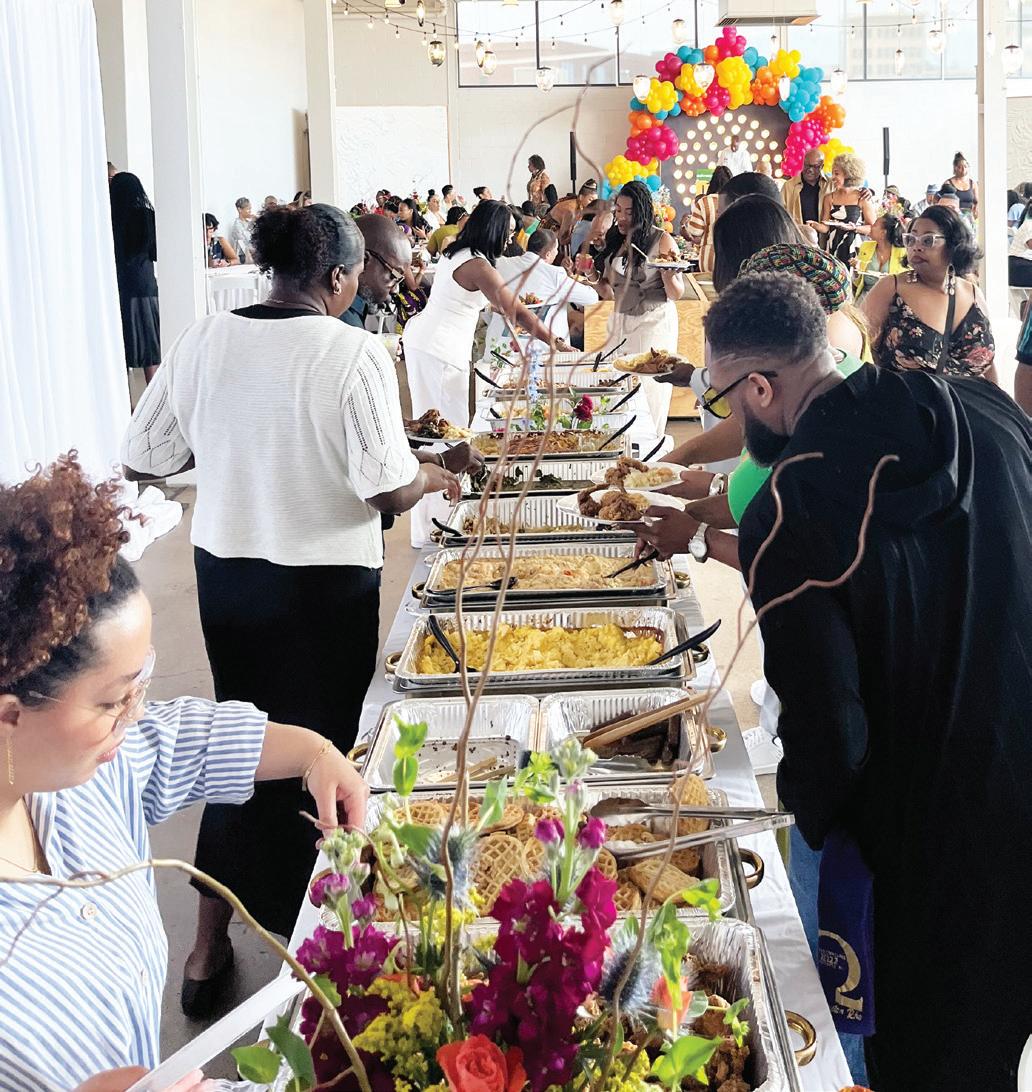
mission to permanently support Black-led change. Founded in the wake of George Floyd’s murder, the Black Collective Foundation is Minnesota’s first Black community foundation and one of only a few of its kind in the country.
Since its inception, the Collective has distributed over $3.3 million in grants to Blackled organizations, entrepreneurs and initiatives in fields ranging from housing to education to transportation.
“We boldly invest in the organizations, leaders, systems and ideas driving justice across the state,” Mola said.
In addition to a community giving campaign launched during the event, the Foundation announced recent initiatives, including the Minnesota Legal Education and Defense Fund, a project providing nonprofit leaders with legal tools to
By Steven Rogers
n June 19, 1865, 2,000
U.S. Union soldiers, after defeating Confederate troops in the Civil War, marched into Galveston, Texas, and informed Black people that they were free men and women.
Gen. Gordon Granger announced that the four-year war, fought over slavery, was officially over. As a result of the Emancipation Proclamation — an executive order issued by President Lincoln in 1863 — all Black people in Texas and the other 10 former Confederate states were no longer enslaved.
His words were:
“The people of Texas are informed that in accordance with a proclamation from the Executive of the United States, all slaves are free. This involves an absolute equality of rights and rights of property between former masters and slaves, and the connection heretofore existing between them becomes that between employer and free laborer.”
This moment marked the end of 246 years of Black people’s bondage in America. That date is now a federal holiday known as Juneteenth.
In 1865, many of the 31 million U.S. citizens — 11 million of whom lived in the former Confederate states — were elated with the outcome. I’m certain every Black person was overjoyed. And two of them were my maternal ancestors, Richard and Susan Duty. Knowing their names makes the Juneteenth holiday deeply personal for me.
The catalyst for my discovery of these relatives came from an 86-year-old retired registered nurse, Lottie Robinson. My
mother’s younger sister, Aunt Lottie, has always been a great storyteller with an outstanding memory. A few years ago, she told me how my family moved from Alexandria, Rapides Parish, Louisiana, to Chicago nearly nine decades ago.
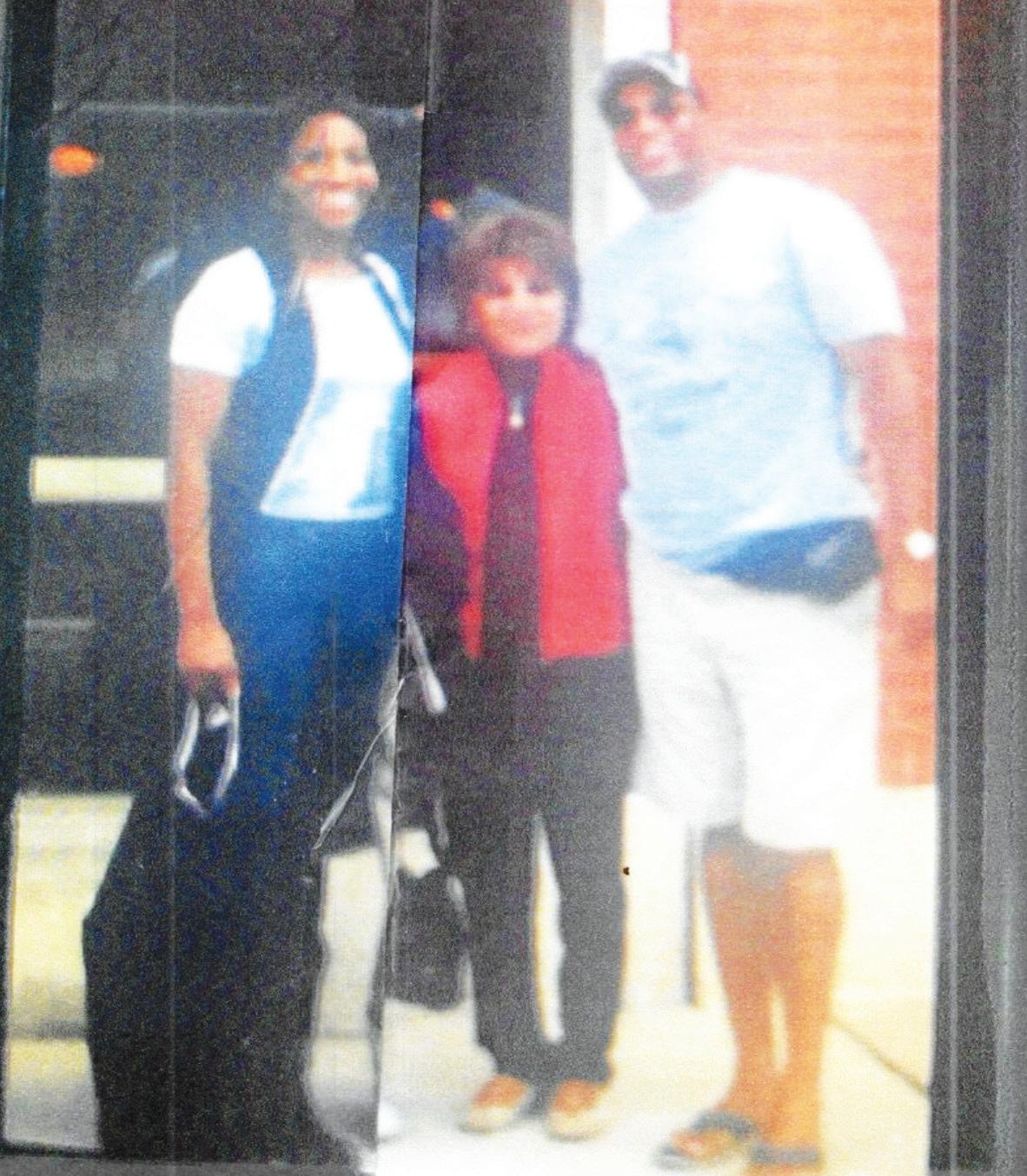
Enthralled, motionless, and beaming with pride, I listened as she recited how my grandfather, James Grant — who was respectfully called “Mr. Grant,” “Jimmie Grant,” and even “Granddaddy” by non-family members — hopped on a freight train in Louisiana in 1938 and rode it all the way to Chicago. Shortly after arriving, he found employment at a steel mill as a mechanic, where he worked until retiring 40 years later.
She also has a vivid memory of them taking her to the station to board the Illinois Central Railroad train bound for Chicago. For many Black southerners, Chicago was known as “the Promised Land.” The allure of the city, combined with the desire to leave
For nearly a year, he sent most of his earnings back to my grandmother, Augusta Grant, who remained in Louisiana with their five children, including my mother, Ollie Mae. As the oldest daughter, she was known affectionately as “Sister,” a prestigious moniker often shortened to “Sis.” While her siblings called their mother “Ma,” my mother called her “M’Dear,” short for “Mother Dear.” A year after my grandfather arrived, my grandmother moved to Chicago with her children, but not all five. Lottie, the youngest, stayed behind for several months with my grandfather’s sister and her husband, who had no children of their own. To this day, Aunt Lottie refers to them with great affection as Aunt Suzie and Uncle Son.
By Katelyn Vue
Federal agents are showing up unannounced at homes throughout Minnesota looking to question minors who came to the United States without parents and legal status, according to immigration attorneys and advocates.
Families in Windom, Worthington, St. Paul and Minneapolis reported that, starting in March, minors in their care have been interviewed by federal agents, according to at least three Minnesota attorneys who work with immigrants.
“This naturally puts a lot of fear into these families,” said Erin Schutte Wadzinski, attorney and owner of Kivu Immigration Law based in Worthington.
The interviews are part of the many new ways President Donald Trump’s administration is tightening immigration enforcement, according to local immigration attorneys, who said the practice was not used by other presidential administrations. ICE spokesperson
Erin Bultje did not respond to questions before publication time.
Many minors who came to the United States without parents and legal status crossed the U.S.-Mexico border and were processed by U.S. Immigration and Customs Enforcement (ICE). While awaiting the outcome of their deportation cases, they are designated as “unaccompanied minors” and allowed to stay in the United States, oftentimes with relatives or a caregiver.
Under Trump’s administration, interviews with unaccompanied minors across the country are called “wellness checks,” supposedly to ensure that minors are following immigration laws and not being exploited, according to an ICE memo. However, the surprise visits are causing fear and confusion for families, said local immigration lawyers and advocates, adding that some minors’ relatives have been taken into ICE custody.
“The welfare checks are typically conducted by plainclothed ICE officers in un-

marked vehicles — officers who only speak English and show up to homes unannounced,”
Schutte Wadzinski said.
There has been an increase of surprise visits in Worthington and Windom in the last few weeks, said Jessica Velasco, Southern Minnesota coalition director of Unidos MN, a statewide immigrant advocacy group. At least 30 confirmed interviews occurred in the past few weeks in the region about 150 to 180 miles south-
west of the Twin Cities, some with unaccompanied minors between 9 and 16 years old, she said.
Typically, two federal agents knock on the door and ask to speak with the minor at the home. Most of the time, Schutte Wadzinski said, families refuse to open the door and instead have the child speak to agents through an open window.
Agents usually ask the child if they have been attending

By Ashley Booker
For more than a century, YWCA St. Paul has stood at the intersection of justice and community. We have been a steady, unapologetic force working to eliminate racism and empower women — a mission that has never been easy, never been universally embraced, and never been more urgent. Today, we find ourselves in a sobering moment. The political landscape is shifting. National policies are retreating from longstanding commitments to equality. Diversity, equity and inclusion (DEI) efforts — once heralded as essential for a just and thriving society — are being targeted, defunded and maligned.
Across the country, nonprofits like ours are being forced to ask hard questions about how we move forward in a climate that has grown
increasingly hostile to the very values that guide our work. Let me be clear: we are not retreating.
At YWCA St. Paul, we are reprioritizing, not because our mission has changed, but because the world around us has. In the face of escalating challenges, we are choosing to align our work with the most foundational framework for human flourishing: Maslow’s Hierarchy of Needs.
If we want individuals and families to thrive, advocate and lead, they must first have their basic needs met. That means food. It means shelter. It means safety, stability, and reliable access to quality care.
That’s why we are doubling down on the areas where we continue to see the deepest and most persistent racial disparities: affordable housing, economic stability, and health and wellness.
According to the Minnesota Housing Partnership, more than one in two Black renters in the Twin Cities spends over 30% of their income on housing, placing them in the “costburdened” category. Meanwhile, the homeownership rate for Black Minnesotans remains just 23% compared to 77% for white residents, one of the widest racial gaps in the country.
On the economic front, Black women in Minnesota are paid just 63 cents for every dollar earned by white, nonHispanic men. That gap is even wider for Indigenous and Latina women. Even more troubling, 60% of Black families in Ramsey County live on an income of less than $35,000 per year, far below what it takes to afford basic necessities.
Then there’s health. Black Minnesotans face some of the state’s highest rates of chronic illness, including diabetes, hypertension, and maternal mortality. These disparities are not new, but they will be deepened by recent shifts in federal policy.
The rollback of Medicaid coverage post-pandemic and the erosion of protections under Title X are expected to disproportionately harm communities of color. Analysts at the Center on Budget and Policy Priorities warn that millions are at risk of losing access to care, especially in states like
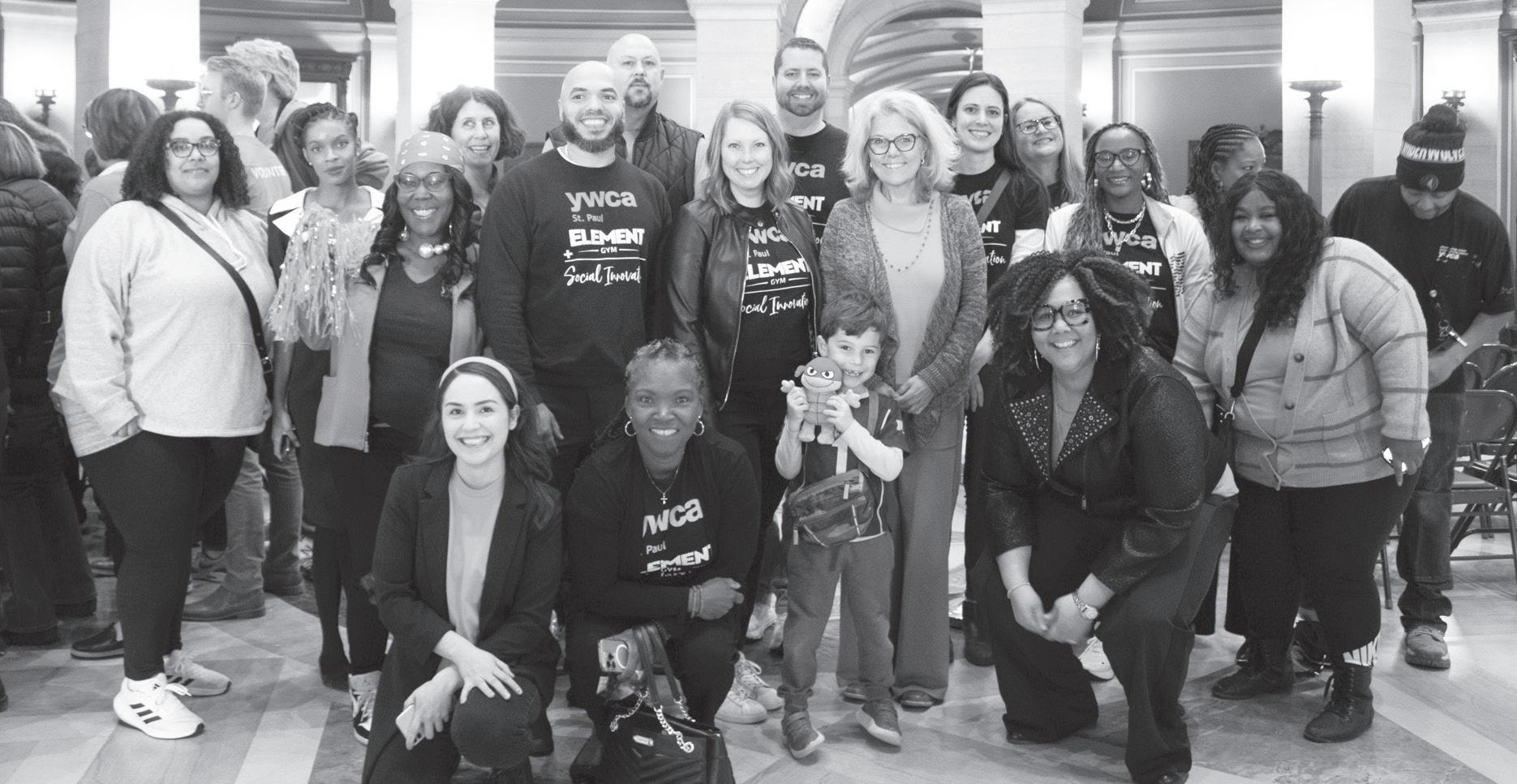
school and immigration court hearings, and also ask about their safety and whether they are working, said Cedar Weyker, an attorney with Advocates for Human Rights, a Minneapolis-based nonprofit that mobilizes free immigration help, among other legal work.
“The questions seem to vary widely,” Weyker noted. Some families have reported brief interviews, she said, while others have reported extensive, longer interviews. Weyker also said families have reported seeing agents from different federal agencies, such as ICE, the Department of Homeland Security and the FBI.
Immigration attorneys say they were shocked by the checks, since the Trump administration didn’t issue a public statement announcing the practice or explaining how the interviews would be conducted. It’s unclear if the interviews are a one-time visit, or if minors will be visited multiple times.
Lindsey Greising, an attorney for Advocates for Human Rights, said attorneys in her office often work with unaccompanied minors, and that it usually takes a long time to build trust with them before they share their experiences with exploitation. Agents showing up unannounced at their homes will most likely
in the wake of generational trauma and systemic neglect.
Let’s be honest: most nonprofits are struggling right now.
But Black-led organizations like ours are being hit especial-

ours where safety nets are already strained.
YWCA St. Paul cannot fill every gap. But we are building bridges where we can.
We’ve made the difficult decision to scale back certain programs and initiatives. We’ve trimmed expenses from already lean budgets and restructured internal operations to ensure every dollar goes where it is needed most. These choices have not been easy, but they are necessary if we are to remain solvent and impactful in a climate where both philanthropic and government support is increasingly uncertain.
At the same time, we’re expanding our commitment to the people we serve. Our housing programs continue to provide safe, affordable shelter and support to families on the brink of homelessness.
Our economic advancement initiatives are connecting BIPOC individuals with training, mentorship, and job placement support that leads to thriving-wage employment.
Our health and wellness programming — including our reimagined Health & Fitness Center — is helping community members reclaim their physical and mental wellbeing
indicate to the minor that the situation is dangerous and will make them uncomfortable, she added.
Asked whether unaccompanied minors and their caretakers should engage with agents, Weyker and Greising said they could not give legal advice about what individuals should do, and encouraged families to consult with immigration attorneys.
Wadzinski said families should know their rights as immigrants if federal agents show up for a check. Some tips she shared include:
● Do not open the door to federal agents.
● Do not sign anything before consulting a lawyer.
● Always carry valid immigration documents with you.
Velasco, who has worked with immigrant youth for nearly a decade, said families who experienced the federal checks worry about being separated from the child under their care.
“The only way we’re going to continue to thrive and grow is if we take care of and ensure that our young people are feeling safe,” she said of unaccompanied minors.
This piece was originally published in Sahan Journal. For more information, visit www.sahanjournal.com.
other Black-led organizations in the Twin Cities — each doing powerful work to serve a community that continues to be deprioritized.
If you believe in this work, any part of it, give what you can to whichever organization resonates with you. The truth is, we all need support. And we all intend to stick around — but it won’t be possible without your consistent support and collective action.
We know moments like this can breed fear and despair. The temptation to scale back the vision, to play it safe, to shrink ourselves in the face of resistance is real. But we also know our history. We know that justice has always required audacity.
Our ancestors didn’t fight to maintain the status quo, they fought to transform it. So while some may attempt to delegitimize this work and reframe justice as unjust, we will not be moved.
ly hard. Traditional fundraising pathways are closing off. Government dollars are disappearing. And the organizations that have always done the most with the least are being asked to do even more — with even less.
That’s why Black philanthropy has never been more essential. YWCA St. Paul needs your support. But so do many
YWCA St. Paul will continue to serve with honor, grace and resolve. We will advocate fiercely. We will tell the truth, especially when it’s uncomfortable. And we will keep showing up and showing out.
Because this is who we are.
Ashley Booker is the CEO of YWCA St. Paul. For more information, visit www.ywcastpaul.org.
By Kaylie Sirovy Contributing Writer
In the heart of North Minneapolis, Broadway Family Medicine is taking a radical approach to addiction treatment: putting people first.
For more than a decade, the clinic has stood on the front lines of Minnesota’s opioid epidemic, offering compassionate, culturally responsive care in a community often underserved and overlooked.
“We provide a stigma-free, no-judgment, all-are-welcome environment for anybody suffering from use disorder — or frankly, any other medical problem,” said Bob Levy, associate professor at the University of Minnesota and director of the Minnesota Substance Use & Community Health Lab (MN-SUCH).
That focus on dignity and meeting people where they are isn’t just good practice — it’s life-saving. Overdose deaths in Minnesota remain high, particularly among Black and Hispanic Minnesotans.
While opioid-related deaths declined 8% statewide from 2022 to 2023, according to the Minnesota Department of Health, the crisis continues in Hennepin County, where Broadway operates. County data show 373 opioid-related deaths in 2023, 94% of them involving fentanyl. Among African Americans, those deaths rose more than 14% from the previous year, jumping from 129 to 148.
“We were the first clinic in Minnesota to offer outpatient opioid use disorder treatment with commercial insurance, including Medicaid,” Levy said. “We’ve trained hundreds of doctors in the last 10 years, but a lot of people don’t know

this help exists.” Broadway’s providers work to counter persistent stigma, which Levy calls one of the clinic’s biggest obstacles. “I hear it from patients all the time: ‘I should just be strong enough to stop,’” he said. “But that’s not how it works. Nobody blames someone for having diabetes. Why should we treat addiction any differently?”
The clinic has recently added a social worker, a patient care navigator, and expanded partnerships to address social factors that contribute to addiction.
Historical distrust of the medical system — especially among Black Minnesotans — adds another layer of complexity. “I’ve heard it directly from people: ‘Don’t tell these white doctors my business,’” Levy said.
“And I get it. There’s a long, ugly history there. That’s why we’re actively recruiting more African American providers to work in our clinic.”
Coordinating much of this work is Mary Lonergan-Cullum, research project manager for MN-SUCH. “We have research, service and community outreach components,” she said.
harm reduction supplies.”
Among their newest initiatives is a patient navigator program to help individuals transition from emergency rooms into long-term care. “It’s not enough to just stabilize someone in the ER,” Lonergan-Cullum said. “We need to make sure they have ongoing support after they leave.”
The team also distributes Narcan, wound care kits, and hygiene supplies through partnerships ranging from grassroots collectives to larger
organizations like the Steve Rummler HOPE Network.
“More Narcan in the community means fewer people dying,” Levy said. “And you can’t treat somebody who’s dead.”
Levy said it’s the individual patient stories that keep the team motivated. One woman came in years ago seeking birth control while struggling with substance use. She returned a year and a half later to thank him. She was sober, employed, and in a stable re

The clinic’s response includes education and outreach, offering free public training on fentanyl, Narcan use, and harm reduction. It’s not just about medication, Levy said.
“We use grant funding not just for data collection, but for direct patient services — things like housing referrals, food insecurity resources, and


lationship.
“‘I would’ve definitely had a kid by now, and that would’ve messed everything up,’” Levy recalled her saying.
Despite looming federal funding cuts that threaten the clinic’s work, Levy and Lonergan-Cullum remain committed. “I’m very worried about that,” Levy said. “We’ve spent a decade building this infrastructure, and it could all just disappear one day.”
Still, the mission is clear.
“This is a medical condition,” Lonergan-Cullum said. “It’s not a choice. It’s not a moral failing. Treatment works, and we should help people where they’re at.”
And for those wondering whether to carry Narcan, her message is simple: “You won’t hurt someone by giving them Narcan, even if it wasn’t an overdose. But you might save their life.”
For anyone struggling, or for those who love someone who is, the message from Broadway Family Medicine is one of hope. “You don’t have to suffer,” Levy said. “You’re not alone. There is help.”
For more information, visit www.mphysicians.org.

Kaylie Sivory is a contributing writer for the Minnesota Spokesman-Recorder.


By Jasmine McBride Associate Editor
The Metropolitan Economic Development Association
(MEDA) honored standout entrepreneurs and community builders Tuesday, June 17, at its 2025 annual meeting, held at the Walker Art Center. The event brought together over 100 small business owners, corporate partners and civic leaders to celebrate the achievements of BIPOC-led businesses in Minnesota and to chart a path forward amid ongoing economic uncertainty.
The meeting featured awards for Entrepreneur of the Year, Community Builder of the Year, Resilient Entrepreneur of the Year, and Small Business Champion of the Year, along with a spirited panel of founders whose businesses have flourished with MEDA’s support. The program was emceed by MPR’s “Min-
nesota Now” host Nina Moini. “At a time when so much is happening in the world, this meeting holds special meaning,” Moini said. “MEDA is not only prepared for this moment, it is positioned to lead this movement.”
MEDA Board Chair Hoyt Hsiao, who passed the gavel to incoming chair Kevin Besikof during the event, reflected on a year of growth and resilience. “It’s been a privilege to serve an organization doing such critical work,” said Hsiao, president and CEO of ShawLundquist Associates Inc. “We are positioned for continued success thanks to the dedication of MEDA’s team and the support of this community.”
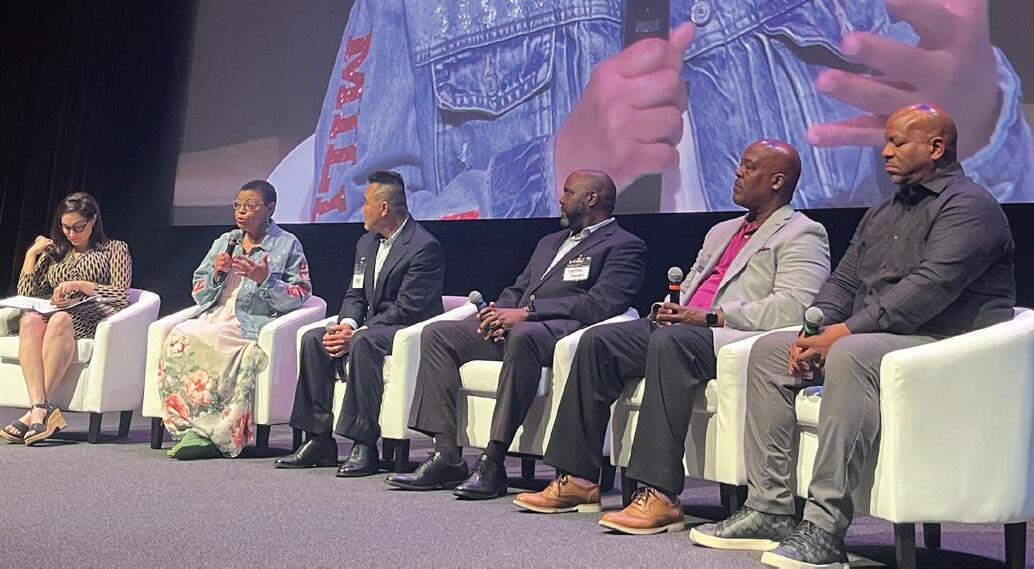
MEDA President and CEO Dorothy J. Bridges acknowledged the “exhausting times” small businesses are navigating — rising costs, reduced access to capital, and the fastchanging impact of artificial intelligence.
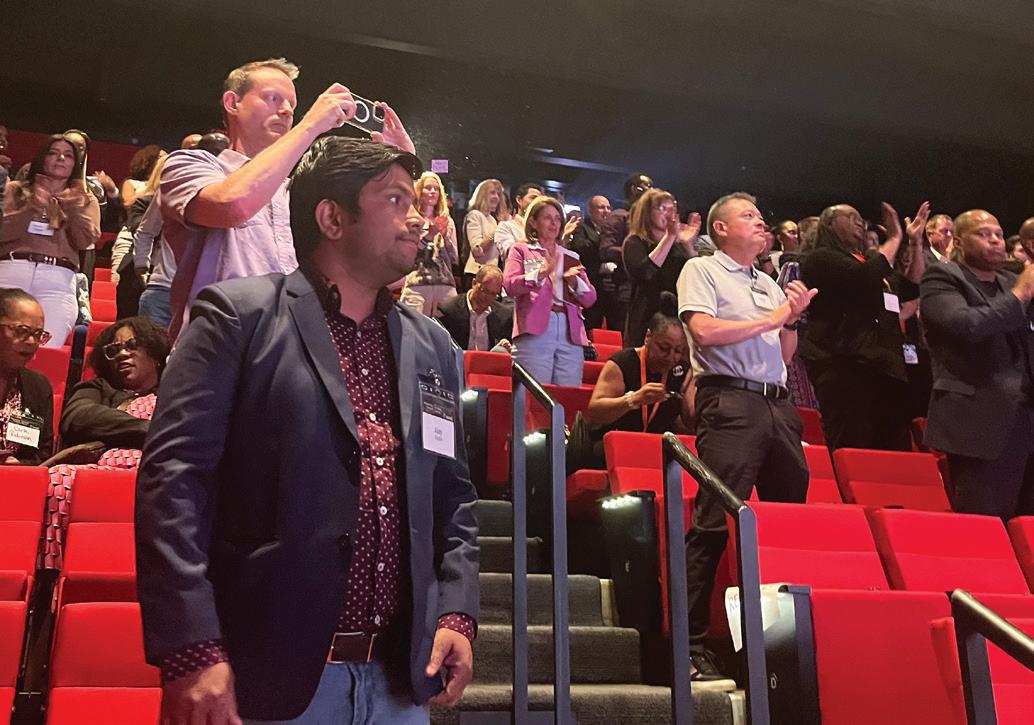
“These changes are not accidental,” Bridges said. “There are forces that would rather see us give up… But here we are, still showing up.”
Bridges emphasized MEDA’s continued commitment to BIPOC entrepreneurs and highlighted the organization’s recent $3.5 million in Promise Act loans as a critical resource for underserved business owners. “Our mission won’t stop until every single entrepreneur has equitable access to the capital and support they need,” she said.
The Entrepreneur of the Year award went to Conrad Nguyen, a former refugee and corporate executive who now leads Kortech, a minorityowned small business connecting talented people to large companies and government agencies for project and construction management, facility support services, and onsite contract staffing. Nguyen credited MEDA with providing early acquisition support and
connections that helped scale his companies.
“When you’re lying in a refugee camp dreaming of becoming someone, it’s hard to believe that one day it will happen,” Nguyen said. “MEDA helped make that possible.”
The Community Builder of the Year award went to the founders of 4RM+ULA — James Garrett Jr., Nathan Johnson and Eric Goodlow — for their architecture firm’s work integrating public art, cultural pride, and community-driven design across the Twin Cities.
“In most spaces we inherit, there was never an intention that people who look like us would be served,” Garrett Jr. said. “We’re creating new spaces, and a new language, that welcome and reflect us.”
Goodlow spoke about mentorship as a central part of 4RM+ULA’s work, especially in a field where fewer than 2% of architects are Black. “It’s important to show young creatives that someone who looks like them has done this
— and can guide them, too,” he said.
Johnson emphasized community inclusion in design: “Sometimes people don’t realize how much knowledge they already have. We help bring that forward.”
The Resilient Entrepreneur of the Year, Rolando BorjaTrujillo of Talent Identifying Systems, was honored for rebuilding his business after a devastating fire nearly drove him to bankruptcy.
“From devastation to revival, Rolando’s journey is a testament to determination and belief,” Moini said. He was unable to attend due to a family emergency.
Local media entrepreneur Sheletta Brundidge, founder of “Sheletta Makes Me Laugh,” accepted the Small Business Champion of the Year award
“Our mission won’t stop until every single entrepreneur has equitable access to the capital and support they need.”
with the humor and heart that have become her signature.
“Tell your story… Tell it again and keep telling it,” Brundidge urged attendees. “Don’t stop telling it, and you won’t have to call the media, they’ll be calling you. If your business has anything to do with the news of the day, jump on it. Talk about it. A TV station will reach out to you. Write an oped for the Star Tribune or Minnesota Spokesman Recorder. Don’t let your foot off the gas — your money will stop coming if you do.”
She encouraged entrepreneurs to be consistent and bold in inserting themselves into conversations. “You can never have too much of you. Be like me, there’s never too much of me. Don’t ever let somebody tell you you’re doing too much. If you’re doing too much, that’s just enough to get you on TV.”
Panelists echoed the importance of representation and opportunity in entrepreneurship. “Hope is the superpower,” Brundidge said, noting the impact of seeing business owners who look like you succeed. “You can’t be what you can’t see.”
Johnson emphasized “access,” describing the challenges faced when doors are repeatedly closed.
Garrett Jr. echoed, mentioning, “We ran a cash-only business for 15 years before we got our first chance at funding,” praising MEDA for opening doors that traditional banks would not.
“MEDA’s superpower is opportunity,” Garrett Jr. continued. “They give deserving folks who aren’t traditionally bankable a chance to grow and thrive.”
As the meeting closed, Bridges reaffirmed MEDA’s vision to transform neighborhoods like Rondo, North and South Minneapolis, and East Saint Paul into “destination points” powered by thriving small businesses.
“Minnesota has been through too much to throw in the towel,” she said. “It’s going to take more than tariff hikes and policy rollbacks to stop us now.”
Jasmine McBride welcomes reader responses at jmcbride@ spokesman-recorder.com.

Continued from page 1
A murmur could be heard as people mostly reflected in silence. As the sun began setting behind the white marble building and darkness began to fall, the glow of candles spanned across the Capitol mall.
Gov. Tim Walz and first lady Gwen Walz stood near the
Continued from page 1
continue race-conscious work in the current political climate.
Co-founder and Nexus Community Partners CEO Repa Mekha opened the gathering with a spiritual invocation and a challenge to attendees to define “the movement of the moment.”
“Our way forward is not something out there we have to discover,” Mekha said. “It lives in us, in our DNA. We must carry a bifocal lens — look at what’s real around us, but also go to the balcony and look long term.”
That philosophy echoed throughout the afternoon.
Mola acknowledged the exhaustion many feel amid political setbacks and violence but said the act of gathering is a cultural response to hardship.
“In my community, when there’s hardship, we come together,” she said. “We cry together. We laugh together. That’s what we do when we’re struggling.”
Continued from page 1
the South, fueled a migration of more than half a million Black people from Louisiana, Tennessee and Mississippi.
Aunt Lottie remembered seeing Uncle Son give money to the Pullman porter, Mr. Jones, so he could look after her during the 15-hour journey. (In the white sections of the train, passengers often called all porters “George.”)
She fondly recalled, with periodic giggles, sitting in the front seat of the train’s “colored section,” happily gazing out the big windows. Her feet dangled in the air as she clutched a paper bag filled with food from Aunt Suzie. Her hair was braided and tied with a flowing red ribbon. She wore a pretty pink dress, white socks, and shiny black patent leather shoes.
When the train pulled into the Chicago station, she said she was overcome with joy at the sight of “my daddy — Jim-
front, head lowered as a candle flickered in his hand and she reached into her purse for a tissue. Lt. Gov. Peggy Flanagan said many current and former House members gathered privately beforehand to grieve together and share stories.
“It really is a family, and Melissa was such an important part,” Flanagan said. “A lot of laughs, a lot of stories, a lot of swears. So today, I have tremendous gratitude for her life and everyone who’s here to
celebrate her.”
U.S. Rep. Angie Craig, who last spoke to Hortman as the Legislature was wrapping up a difficult session, was there, too.
“Today was the first day that we could all tell our stories together. We could gather together in our grief, and we needed it,” Craig said. “We really did need it.”
Organizers advised attendees to leave signs at home and purposely avoided a speaking program.

The Collective’s participatory approach to philanthropy was another key theme. Board Chair Aretha Green-Rupert, who has spent 15 years in the field, said what makes the organization different is its community-led model.
rience. We let community lead.”
Green-Rupert added that the Collective is rooted in a long legacy of Black generosity. “Black folks have always given. We give more of our income than any other racial group,” she said. “Whether that’s open-
“Some of our spirits may be high and some of our spirits may be low, but our spirits are together, and that’s what matters.”
“We’re not doing philanthropy in the old way,” she said. “Decisions about where money goes, and how communities are impacted, are made by folks on the ground with lived expe-
mie Grant!” He jumped onto the train, scooped her up in his arms, kissed her cheeks, and gave her a big, playful “zerbert” — a noisy kiss on the stomach that made her laugh uncontrollably. He then drove her to their apartment at 25 E. 116th Street in the Roseland neighborhood.
Ten years later, they became the first Black family to buy a house on their block in Englewood. They purchased it “on contract” from a white owner, at an interest rate of 16%, significantly higher than the mortgage rates available to white families. This was due to redlining, the federal policy that prevented banks from offering mortgages to Black families.
Eventually, my grandparents secured a mortgage from Sears, Roebuck and Co., at a much lower rate of 5%.
Over time, Aunt Lottie shared other family stories, though with fewer details.
One moment that stood out was when she proudly declared, “Your great aunt, my daddy’s sister, was a WAC!” She said nothing more.
Curious, I did some re-
ing our homes, feeding our neighbors, or tithing at church — we’re building a philanthropic model that reflects our culture and our history.” That culture of recognition
search. I learned that this great-aunt was one of 6,500 Black American women who served among the 140,000 in the Women’s Army Corps during World War II. Her service and patriotism matched that of the countless Black veterans who have fought in every American war since the Revolution, more than any other racial or ethnic group.
“Find the ‘Aunt Lotties’ in your family, especially if you’re Black and your lineage stretches back generations in America.”
The word Juneteenth is a portmanteau, like “chatbot,” a modern word combining “chatter” and “robot.” Juneteenth combines “June” and “nineteenth,” the day in 1865 when millions of Black people gained their freedom.
While my aunt didn’t know the specific significance of that date for our family, one simple sentence changed everything. She said, “I remember an el-

A funeral service for the Hortmans is not expected prior to next week, although details have yet to be made public.
Gov. Tim Walz told MPR News this week [of June 16] that Hortman deserves to lie in state in the Capitol, an honor that is usually afforded to former governors and other prominent officials. Hortman would be one of fewer than 20 Minnesotans — and the first woman — to receive the tribute since this Capitol build-
was palpable among this year’s Nuance Fellowship recipients, several of whom attended Rooted & Radiant. The program provides support, visibility and community to Black changemakers across Minnesota.
Dr. Kasim Abdur Razzaq, a 2023 fellow, described the experience as “transformational.” “The affirmation that not only what we’re doing, but how we’re doing it, is something the community recognizes — that meant everything,” he said.
Razzaq is currently launching Heal Black Minnesota, a nonprofit aimed at creating pathways for culturally grounded Black mental health professionals and a consortium of Black-led service organizations.
Leesa Kelly, a 2025 Nuance Fellow and founder of Memorialize the Movement, said the fellowship has helped her build vital relationships.
“Through this fellowship, I’ve connected with so many incredible Black leaders,” said Kelly, who moved to Minneapolis from Chicago in 2017. “It’s already paid off immensely.” Kelly recently hosted the
der in our family once saying we have people who owned a little town in Louisiana.”
That led to the discovery of my great-great-greatgrandparents Richard and Susan Duty. Richard was born in Louisiana in 1824. Susan (nicknamed Sookie) was born in Kentucky in 1823, with the maiden name Madden.
This history was unearthed thanks to a Father’s Day gift from my daughter, Ariel (an Evanston Township High School alum), who hired genealogist Christopher Smother to trace our family lineage. Christopher, owner of Unearthing Your Roots Inc. in Louisiana, did an incredible job tracing our ancestry back more than 200 years. He’s the same genealogist who helped uncover Pope Francis’s Black heritage in New Orleans.
His research also verified Aunt Lottie’s story about our family’s contribution to a small town in Bienville Parish, La., where Richard and Susan settled after the 13th Amendment was ratified in December 1865.
That amendment officially abolished slavery in all 31
ing opened in 1905, according to the Minnesota Legislative Reference Library.
There have been only four who were solely state legislators and didn’t serve in statewide office, such as governor or Supreme Court justice. No legislator with exclusively Minnesota House service has been given the tribute. The last legislator so honored was former Senate Majority Leader Nick Coleman.
Authorities say the alleged
a lengthy list of possible targets and
the homes of

final Justice for George event at Phelps Field Park and is now planning a new Black Liberation Archiving and Conservation Center to preserve and educate through mural work.
Looking ahead, the Black Collective Foundation MN is planning its next major convening: the Collective Summit, scheduled for Nov. 18-20.
states, not just the 11 covered by the Emancipation Proclamation. Which means that for six months after Juneteenth, slavery was still legal in parts of the U.S.
Once freed, Richard and Susan became entrepreneurs.
Through hard work, frugality and faith, they emerged as selfless leaders and philanthropists in the Black community. According to the History of Bienville Parish:
“Richard was Methodist by religious faith, and Susan was Baptist. They gave land and built the first C.M.E. church called St. Duty. They also bought land and built the first Black Baptist church in Arcadia. They gave land and built the first school for Black boys and girls in Arcadia. They also gave land for the St. Duty cemetery, where many Blacks throughout the area, including Susan, who died in 1871, and Richard, who died in 1884, are buried. He left more than 700 acres of land, houses and livestock.”
“We look forward to growing, to increasing our assets, and to starting our endowment,” Mola said. “We’re committed to being here 100 years from now, for the good of our community.”
Jasmine McBride welcomes reader responses at jmcbride@ spokesman-recorder.com.
So as we celebrate Juneteenth today, I encourage you to find the “Aunt Lotties” in your family. Especially if you’re Black and your lineage stretches back generations in America, I am certain your journey will lead you to discover formerly enslaved ancestors like Richard and Susan Duty, people who should be honored on Juneteenth and every day as American heroes and she-roes.
Steven Rogers wrote about his Aunt Lottie and her memories regarding Juneteenth. She lives in Minnesota.
Learning this made me swell with pride. But it also made me sad, knowing these wonderful people had once been enslaved. That same bittersweet feeling returns every Juneteenth, a day of mourning and celebration. I experienced it again when I called my aunt with the good news that she was right. We did have ancestors who were major contributors to their community. She listened quietly, then shared that she had recently been diagnosed with Lewy body dementia. I silently cried. It was devastating to hear that about a woman with such a brilliant mind.
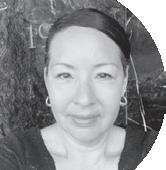


By Robin James
“Summertime, and the living is easy,” as the lyrics to that beloved song go. It’s the season for jazz festivals and music in the open air — but if you’re not traveling or attending live shows, there’s still plenty of great music to create your own summertime soundtrack indoors.
Speaking of travel, Savant Records has just the thing for you: “Travelogue,” the latest release from gifted pianist Danny Grissett. Along with bassist Vicente Archer and drummer Bill Stewart, Grissett delivers swing, lyricism, and harmonic sophistication on this new set, released in May.
The album reflects life as a traveling jazz artist, featuring mostly original compositions by Grissett. Listeners who join the journey will be rewarded with a colorful musical landscape built on rhythmic mastery and emotional depth.
Tracklist
• The Long Way Home
• Wonder Wander
• Interlude: Inbound
• The People in the City

• Picture in Picture
• Whisper Not
• Interlude: Outbound
• The After Hours
• Here’s That Rainy Day
• Spin Cycle Grissett isn’t the only one with new music this summer.
Bassist Christian McBride returns with “Without Further Ado, Vol. 1,” out Aug. 29 on Mack Avenue Records. The album features an impressive guest list, including Sting, Andy Summers, Samara Joy, José James, Cécile McLorin Salvant, Dianne Reeves, Jeffrey Os-
borne and Antoinnette Henry.
Another standout pianist and Mack Avenue labelmate, previously mentioned in this column, is Isaiah J. Thompson. His new album, “The Book of Isaiah: Modern Jazz Ministry,” was just released. The project is described as a spiritual and autobiographical statement, exploring faith, musicianship, race and humanity. One of my favorite pianists, Cyrus Chestnut, co-produced the album. Also from Mack Avenue Records, “Elemental,” a duet album by vocalist Dee Dee


Bridgewater and pianist Bill Charlap, dropped on June 13. After years of sold-out live collaborations, it’s a joy to see them bring that synergy into the studio. Both artists are steeped in tradition and known for their dynamic range. Closer to home, the classic Twin Cities Jazz Fest wrapped up another successful year this past weekend in St. Paul. Looking ahead, vocalist Lizz Wright, no stranger to the Twin Cities, will perform at the Dakota on July 9. I still remember discovering her debut album, “Salt,” back in 2003. Her live recording “Holding Space: Lizz Wright Live in Berlin” is another gem worth checking out. For tickets, visit www.dakotacooks.com.
In August, the iconic Newport Jazz Festival kicks off in Rhode Island. While I won’t
be traveling there this year, I’m excited for a jazz festival closer to home. The 24th annual Selby Avenue Jazz Festival takes place Saturday, Sept. 13, from 11 a.m. to 7:30 p.m. at Milton Street and Selby Avenue in St. Paul. It’s a free, family-friendly event featuring kids’ activities, artisan vendors, and great food.
This year’s lineup includes Cory Henry & The Funk Apostles, The Yuko Mabuchi Trio, Heyarlo, Brio Brass, the Walker West Jazz Ensemble, and the Selby Avenue Brass Band. I always look forward to the Walker West Jazz Ensemble; they represent the next generation of jazz and sound fantastic.
For more information, visit www.selbyavejazzfest.com.
Finally, closing out the season on a high note, the Jazz at
Lincoln Center Orchestra with Wynton Marsalis presented a celebratory performance, The Best of JLCO with Wynton Marsalis, on June 13 in New York City. I watched via livestream, and it did not disappoint.
Highlights included “2/3’s Adventure” by bassist and composer Carlos Henriquez, Vincent Gardner’s vocal take on “Yes Sir, That’s My Baby,” and Paul Nedzela’s moving baritone saxophone solo on John Coltrane’s “Alabama.” Jazz at Lincoln Center’s 38th season, Mother Africa, will unite African and American musical traditions. The season runs from July 24, 2025, through June 20, 2026.
Robin James welcomes reader responses at jamesonjazz@ spokesman-recorder.com.






By Kaylie Sirovy Contributing Writer
In a small fellowship hall
in the Seward neighborhood of Minneapolis, a new kind of school is quietly challenging how early childhood education works, especially for Black children. Morning Glory Montessori, an all-boy faithinformed school, is more than a preschool. It’s a mission.
“I knew that this is what our community needed,” said co-founder Rev. Jessica Jackson, better known as Pastor Jess. “Not enough people in the African American community knew about Montessori, and because of the disparities here in Minnesota, parents are looking for something different. What happens in these foundational years is so impactful on what comes next.”
Montessori education emphasizes exploration and independence, concepts that challenge both mainstream early childhood models and harmful stereotypes about Black children, particularly Black boys.
For Jackson, the journey to founding Morning Glory began decades earlier. Her mother, Ruby Hughes, was a trailblazer in early childhood education
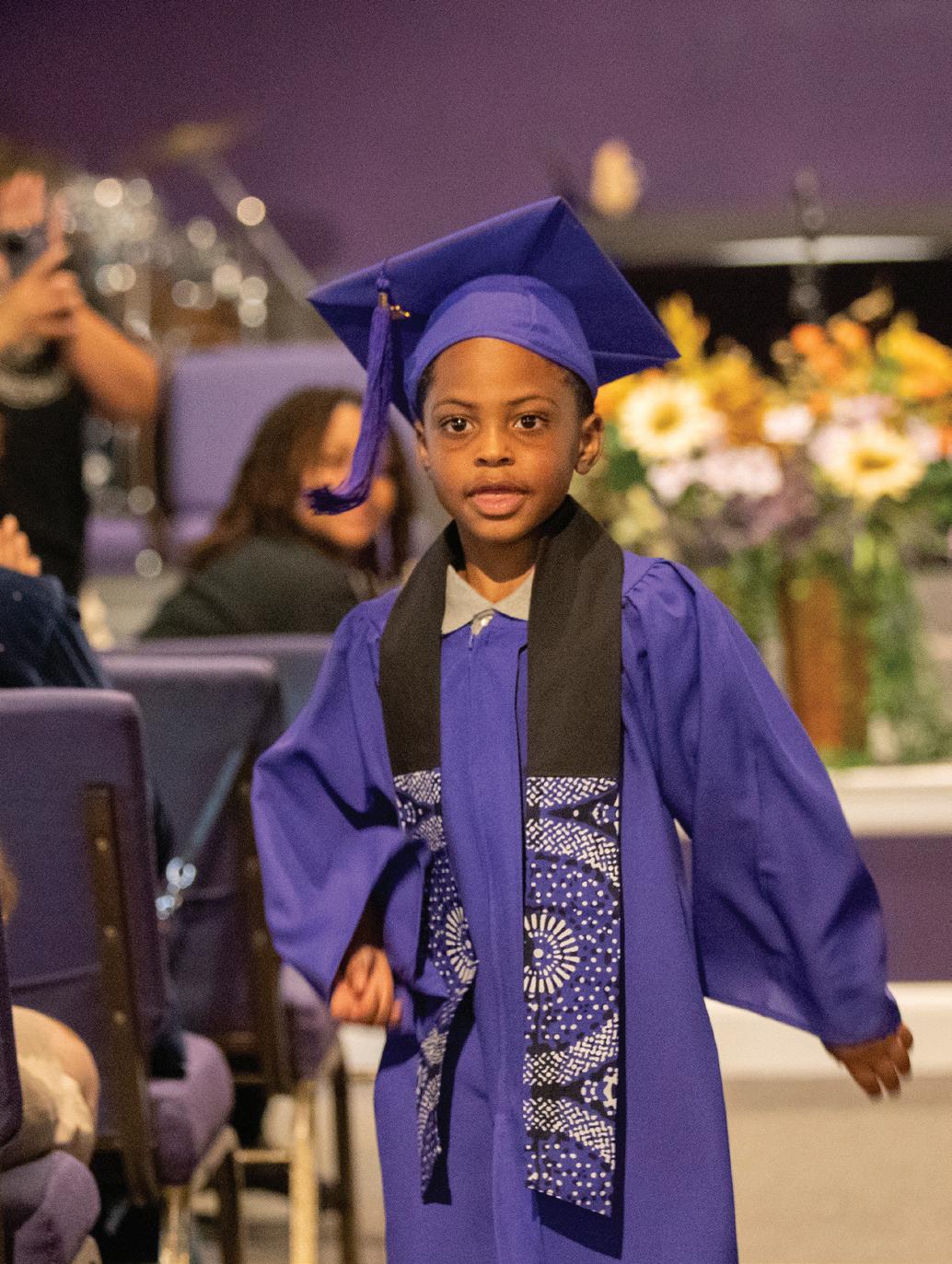
ministry, those early seeds took root.
“It was a full-circle, divine moment,” Jackson said, recalling the day she met Montessori trainer Molly O’Shaughnessy, who told her she knew her mother. “That was it for me. I
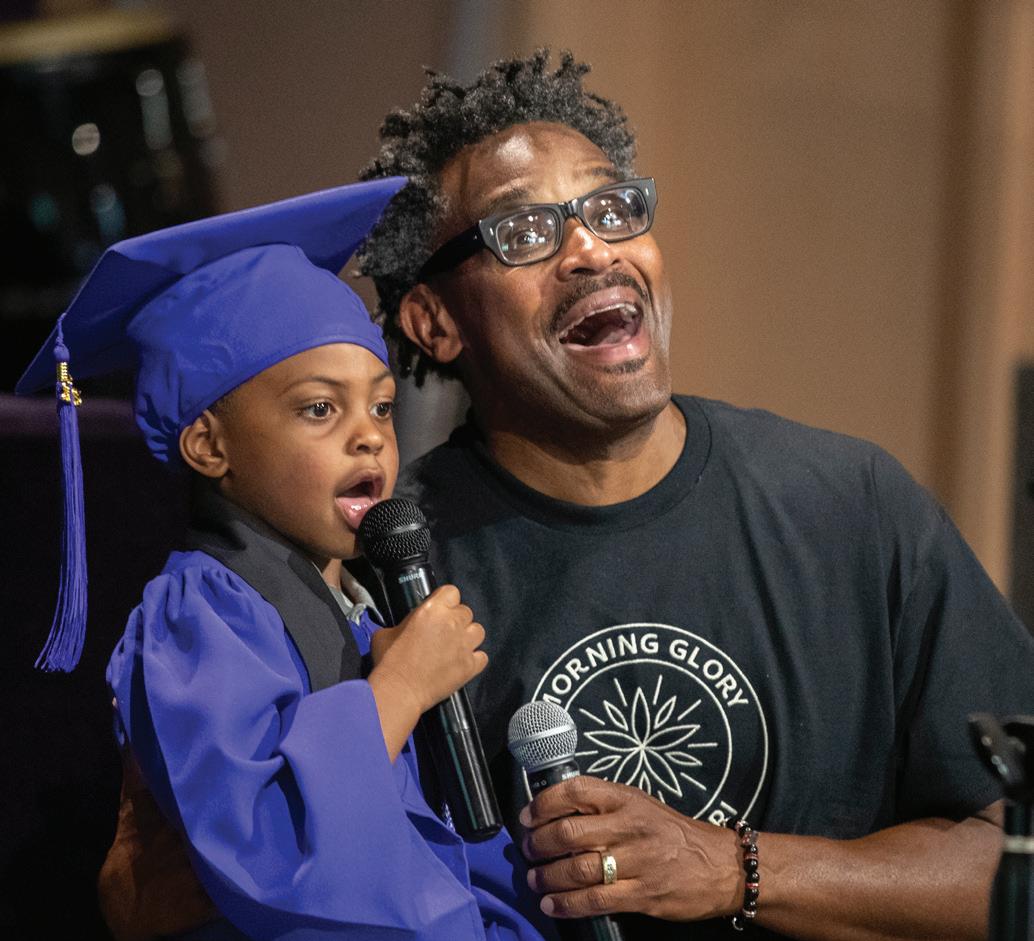
on Minneapolis’s North Side, founding La Crèche, one of the city’s oldest Black-led child care centers.
Montessori first entered the family’s story in the early 1990s, when Hughes converted one of her classrooms to a Montessori environment. Jackson didn’t fully understand its significance at the time, but years later, as she pursued her own path in education and
felt like I was called to do this.”
But vision alone wasn’t enough to open a school. It took nearly seven years of searching for space, raising funds, and navigating zoning and licensing hurdles before Morning Glory Montessori opened its doors in September 2024.
Now operating out of the lower level of Kingdom Life Church, the setting offers a
surprising transformation. Upstairs, it remains a traditional church; downstairs, it becomes a child-centered learning environment — filled with small tables and chairs, vibrant materials, and a classroom designed around the needs of young children.
Teachers at Morning Glory aren’t called teachers, they’re called Guides, a Montessori term that reflects their role as facilitators of discovery rather than lecturers. The goal is not just academic instruction, but the creation of a community.
June 17, that community gathered to celebrate a major milestone: the graduation of one of its first students.
Outside the church, families shared food and laughter while children practiced yoga poses on the lawn.
The school’s intentionally small size, just two students in its pilot year, is part of its longterm vision.
“We want to grow, but we want to maintain the integrity of what we’re doing,” said Maya Burnaugh, a board member and parent. “Sometimes when you grow too quickly, you lose some of that integrity. And at the core of our mission is really to support Black boys.”
Burnaugh, who attended mostly white private schools as a child, often felt like an outsider. As a parent, she said, she now understands the importance of children learning

in environments where they are seen and affirmed.
“I think he’s really grounded now,” she said of her son. “He can take that into other spaces, where maybe he’s going to be the minority again, and still have that confidence and belief in himself.”
Morning Glory’s curriculum extends beyond academics.
The Rev. Dr. Timothy Jackson, Pastor Jess’s husband, serves as director of faith pedagogy and leads the school’s spiritual foundation. His work is rooted in the teachings of theologian and civil rights leader Howard Thurman.
“The spirituals guided our ancestors through the antebellum South and civil rights and even today,” Dr. Jackson said. “It’s important that we revisit the past so that we don’t repeat it. This is our justice work. This is our civil protest.”
“This is our justice work. This is our civil protest.”
For the Jacksons, the school is also a direct response to systemic injustice in early education. “Black boys are criminalized at the early age of three,” Pastor Jess said. “It morphs their personality, and they begin to self-hate. The wonderment is snatched from them.”
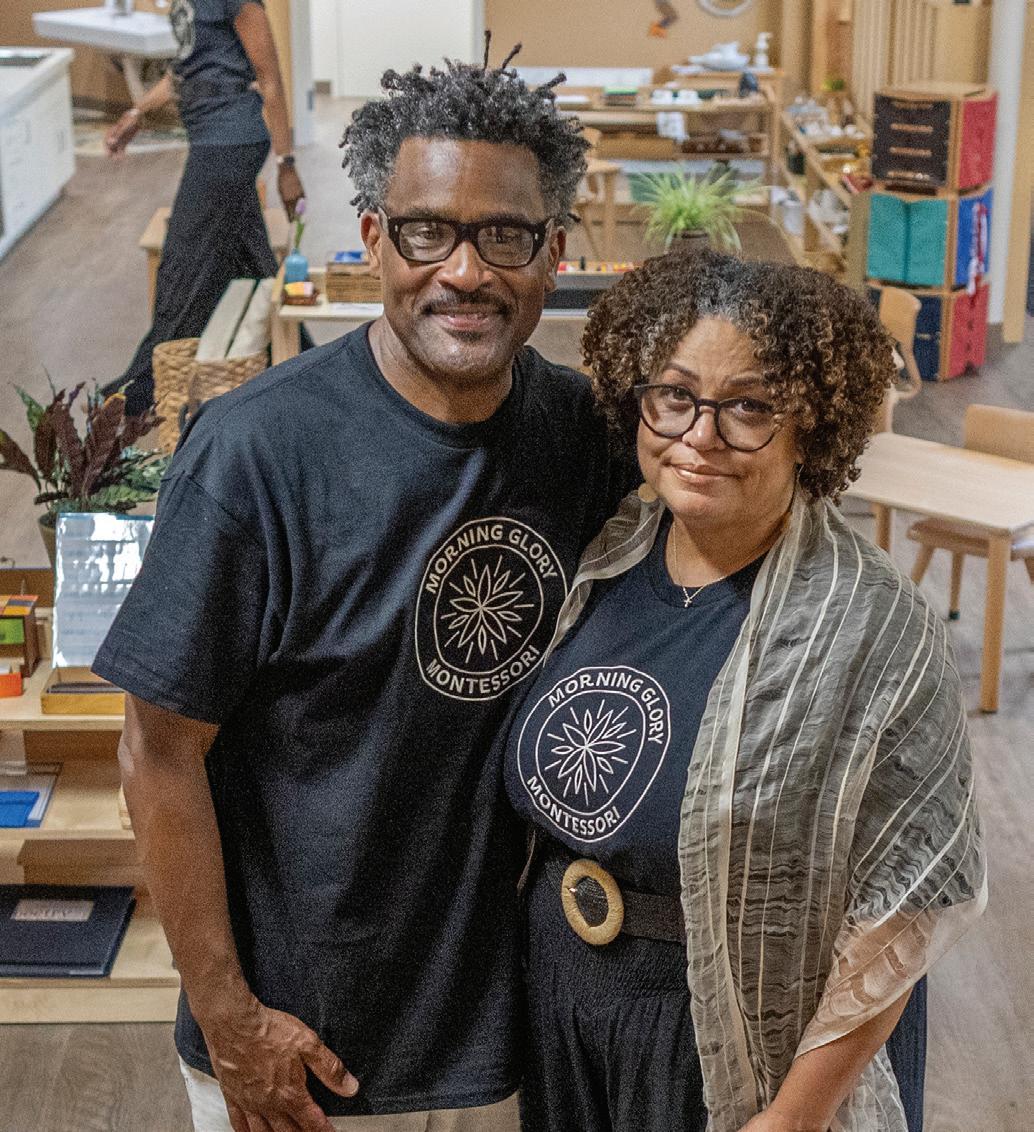
She said Morning Glory’s aim is to protect that sense of wonder, and to raise children who are strong, confident, and rooted in their worth.
Despite strong community support, financial barriers remain. Tuition assistance is a key challenge for families who do not qualify for government subsidies but still struggle to afford private preschool.
Fundraising efforts are now focused on expanding scholarships to close that gap.
So far, word of mouth has been the school’s strongest recruitment tool, as families share their positive experiences with others.
As Morning Glory prepares
for the upcoming school year, Jackson said the focus is on growing with care. “We’re growing — not fast, but intentionally,” she said.
“We want to grow the right way. I want these kids to know: You belong here. You are smart. You are worthy.”
Morning Glory Montessori has plans to expand their programming to serve toddlers through 3rd grade, including girls. For more information, visit www.morningglory.org
Kaylie Sirovy is a recent journalism grad and contributing writer for the Minnesota Spokesman-Recorder.




By Nekima Levy Armstrong
Friends, I need to say this.
This article [titled “Childhood friend says Minnesota suspect had ‘darkness inside of him’] by MPR News about Vance Boelter, the white man accused of a horrifying act of domestic terrorism in Minnesota, follows a familiar and dangerous pattern.
Rather than centering the trauma, fear and damage caused by this man’s actions, it humanizes him. It paints a portrait of a “troubled soul” with a “darkness inside,” struggling with mental health and financial challenges. This framing evokes
sympathy, not accountability.
We’ve seen this before.
Time and again, white male domestic terrorists are given layers of complexity in the media: childhood backstories, psychological profiles, neighborhood quotes.
Meanwhile, when a Black person is accused of a crime, the headlines dehumanize.
The coverage flattens. No childhood context. No empathy. No nuance. And when Black people are victims of murder, especially at the hands of police, articles like this are nearly nonexistent.
This is narrative bias.
This kind of reporting is
harmful. It reinforces the myth that white violence is somehow more understandable, more forgivable. That it deserves exploration instead of condemnation. In essence, this is a form of racialized storytelling that protects the image of white suspects at the expense of truth and accountability. We deserve better. So do the victims. And the truth is owed to the public, not just a convenient narrative.
is a civil rights attorney and the founder of the Racial Justice Network.
By Cicley Gay
Juneteenth, America’s newest federal holiday, was meant to symbolize a national reckoning with history and a celebration of freedom when President Joe Biden signed the bipartisan legislation into law in 2021. Yet, just a few years later, we find Juneteenth events canceled in cities across Indiana, Illinois, and Oregon, as backlash against diversity, equity, and inclusion (DEI) initiatives intensifies.
This is not just an administrative shift — it’s a cultural one. As some seek to erase or diminish Black joy, we must remember that indulging in joy itself has always been an act of resistance.
But Juneteenth also reminds us that freedom in America has never been granted equally. It was delayed for enslaved Black people even after it was declared. Today, for many immigrants, especially Black and brown families, freedom is once again being delayed and denied at borders, in detention centers, and through discriminatory policies. The struggle for liberation is ongoing, and it is interconnected.
Juneteenth itself com-
memorates the moment when freedom finally reached the enslaved in Galveston, Texas, two and a half years after the Emancipation Proclamation. That delay was not just a historical footnote; it was a wound that echoes across generations.
“In the face of those who would turn back the clock, we choose to move forward, fueled by the power of joy as resistance.”
Today, asylum seekers and migrants, many of them Black and brown, live in limbo, waiting for freedom. The delay may look different, but the harm is the same.
At Black Lives Matter, we believe that in the face of attempts to silence and suppress, investing in joy is a radical, necessary form of protest. This Juneteenth, we invite all to join us in celebrating and investing in Black and brown joy as a cornerstone of true liberation, while also standing in solidarity with all who are still waiting for freedom to be realized.
The attacks on DEI and the cancellation of Juneteenth events are not isolated inci-

dents; they are part of a larger movement to strip Black communities, and other marginalized groups, of resources and visibility. In this climate, our resistance must evolve.
Our response cannot be limited to protest alone. It must also include reclaiming the right to thrive, to play, and to experience joy.
From the earliest Juneteenth celebrations to today’s block parties and art festivals, play and happiness have been tools for survival and defiance.
For Black and brown communities, joy has always been revolutionary. BLM was founded in 2013 in response to unspeakable tragedies. Ruthless oppression, abuse of power and brutalities flooded our social media timelines following the murder of innocent young men like Trayvon Martin and Michael Brown.
Yet even in mourning, our communities found ways to laugh, dance and dream together. The movement’s global resonance is rooted in this duality, the courage to confront injustice, and the audacity to celebrate life.
Juneteenth also invites us to ask who in America is still fighting for our freedom? Black and brown immigrants, refugees, and asylum seekers face family separation, lack of running water, lack of due process, unsanitary conditions, and more.
By Jon Jeter
On Monday, interim U.S.
Attorney Joseph H. Thompson said 57-year-old Vance Boelter had compiled a hit list of more than 45 elected officials in the state, all Democrats, and was carrying out his attacks early Saturday morning when he was confronted by patrol officers in a suburb north of Minneapolis.
Thompson would not address Boelter’s motives, but a friend, David Carlson, told CNN that Boelter was a conservative who was staunchly opposed to abortion. In texts to his wife and daughters, Boelter seems to acknowledge that he was motivated by the same sense of aggrievement that has animated reactionary white male terrorists dating back to Timothy McVeigh, who was executed for the 1995 bombing of the federal courthouse in Oklahoma City;
Dylann Roof who gunned down nine Black worshippers at Mother Emanuel African Methodist Episcopal Church in Charleston, S.C. 10 years ago this week; and 18-yearold Payton Gendron who fatally shot 10 African American shoppers at a Buffalo grocery store in 2022.
Wrote Boelter in one text: “Dad went to war last night… I don’t wanna say more because I don’t want to implicate anybody.”
The slain state Representative, Melissa Hortman, and her husband Mark were white, but their killings appear to bear all the hallmarks of an attack carried out by a “lone-wolf” gunman angered by people of color or white liberals whose political values he considers a threat to white America.
Such attacks are sparked by an economic downturn like the Great Recession that
began in 2008, and coincide with a surge in state violence targeting African Americans by a ratio of nearly three to one over whites. According to data compiled by the Washington Post, nearly 2,500 Blacks were killed by police nationwide between January 1 2015 and January 1 2025. That includes several high-profile cases in the Twin Cities. Minnesota’s rightward political shift serves as a validation of Smathers’ riposte to Humphrey’s advocacy for civil rights 65 years ago and a reminder that liberalism is no less a failed political ideology than conservatism.
Jon Jeter is a former foreign correspondent for the Washington Post. This is a portion of “As the State’s Complexion Darkens, Minnesota’s Liberalism Wanes.” For the full article or more information, visit the www.blackagendareport.com.
nurture hope and rebuild.
This Juneteenth, let us do more than remember the past.
Let us build the future. Migration is a declaration of hope.
submissions@spokesman-recorder.com
ads@spokesman-recorder.com
submissions@spokesman-recorder.com submissions@spokesman-recorder.com.
Undeniably, the same forces that once delayed emancipation, white supremacy, and profit-driven policy, now shape immigration enforcement and send troops when we have the audacity to rise up in cities like Los Angeles. True freedom is not just the absence of harm; it is the presence of opportunity, creativity and fulfillment. BLM is evolv-
ing to meet the needs of our most vulnerable, investing in programs that provide access to art, wellness, and community spaces. We will continue to advocate for divestment from police, prisons, and punishment paradigms while also pushing for investment into justice, joy and culture. More recently, we’ve invested in youth sports programs in local communities and abroad, from Brooklyn, New York to Ghana, to ensure we are building from the inside out and advocating for the most vulnerable. We are guided by the wisdom of our ancestors, who, even in the darkest times, found ways to

Just as Black Americans fled the South during the Great Migration seeking dignity, safety and opportunity, today’s immigrants are doing the same. We call on local leaders, philanthropists, and allies to invest in Black communities and to stand in solidarity with all who are still fighting for freedom. The rights to give, to gather, and to celebrate are as vital as any policy change.
Let this Juneteenth serve as a vision for what America can become. In the face of
those who would turn back the clock, we choose to move forward, fueled by the power of joy as resistance. This year, and every year, let us honor Juneteenth with bold action and the unwavering belief that freedom includes the right for everyone to play, to dream, and to live fully.
Will you join us in shaping the future on our own terms, until all are free?
Cicley Gay is board chair of Black Lives Matter Global Network Foundation. This piece was originally published in Black Press USA. For more information, visit www.blackpressusa.com.



Minnesota Spokesman-Recorder June 26, 2025




RATE: $44.60 PCI TOTAL: $178.40
Please proof, respond with email confirmation to ads@ spokesman-recorder.com
Name:
The MSR handles billing digitally. This means you will get e-tears and e-mailed invoices unless you specifically request a hard copy.
Address:
Continued from page 10
a lot of people try to demonize [second-year WNBAer]
Angel Reese… People aren’t fact checking. They just let people tell them anything and run with it because it’s easier than thinking, than processing information, than validating [it].”
Item — “So why do Black coaches still get treated like hype men, not strategists?”
“[There is] underrepresentation in the newsroom, underrepresentation as media executives,” explained McKenzie. “There’s still a level of gatekeeping. There’s a fear of Black leadership, of Black people taking over and taking up too much space because they’re uncomfortable in it.”
McKenzie advocates for more Blacks in sports me-
Continued from page 10
among 32 players, including over 20% of the players selected in the 2025 WNBA draft, that will be competing on eight different teams in the 3XBA (3x3 Basketball Association) two-day tournament in Spokane, Wash. on Friday June 27 and Saturday June
dia. “We need more people in spaces that will educate, elevate and give back and continue to hold accountable those that are treating us badly,” she surmised. “We need to teach people how to treat us... We need more people, and obviously in leadership.”
“We need to teach people how to treat us.”
McKenzie regularly holds webinars for parents and teens who are active on social media, her latest scheduled for June 26. “I think we continuously have to build our own and amplify Black media,” she said.
Charles Hallman welcomes reader comments to challman@ spokesman-recorder.com.
28. Last week Johnson signed to play pro ball in China later this year. Pluto TV and All Women’s Sports Network (AWSN) will stream the event live. AWSN, co-founded by Whoopi Goldberg, recently joined Pluto TV to launch FAST (Free Ad-Supported Streaming Television), streaming TV without a paid subscription.
Charles Hallman welcomes reader comments to challman@ spokesman-recorder.com.

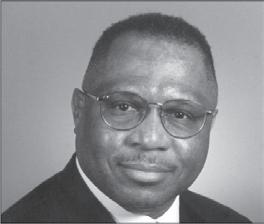
City/State/Zip:
Phone:
Email Address:
induction] is always in my mind.”
Continued from page 10
my family trusted her.”
I first ran into Brantley at the airport and shared a cab when we learned we were staying in the same downtown hotel. She told many stories of her playing years with Kyvallos, all of them with fondness and grace.
“I’m glad she got her flowers while she was alive, and we got to show her how much we appreciate her while she could hear us,” said Brantley as she stood with her former coach and now WBHOFer.
Weatherspoon said after the ceremony, “This is an awesome experience. That memory [of her 2010
“The players are well deserved,” said founding WNBA president and now Big East Commissioner Val Ackerman of Fowles, Beard and Bird. She also is in the Hall (2011).
Former Duke coach Gail Goestenkors (2010 WBHOF) said of Beard, who played for her in college, “She has always done the hard thing to make herself better.”
Fowles said in her acceptance remarks, “It is not just about basketball. Even though my name is on the hall of fame trophy, this moment belongs to us all.”
Charles Hallman welcomes reader comments to challman@ spokesman-recorder.com.


Continued from page 10
point guard, University of South Florida. Her court savvy and outstanding play on defense is in addition to a 13.4 points per game average.
Alanna Smith, 6’4” center, Stanford University. She’s contributing 9.8 points per game as an inside force.
Natisha Hiedeman, 5’8” point guard, Marquette University. She’s chipping in 8.9 points per game in addition to outstanding backcourt play.
Jessica Shephard, 6’4” center, University of Notre Dame. Averaging 7.6 points per game goes along with her rebounding on both ends.
Bridget Carleton, 6’2” forward, Iowa State University. She’s contributing 6.4 points per game with her outside shooting.
Maria Kliundikova, 6’4” center, Dynamo Kursk/Russia. She’s averaging 6.0 points per game in addition to rebounding and shot blocking.
The game
Playing without injured leading scorer Collier, McBride exploded for 29 points, Williams had 18 and Kliundikova added 12 in the victory over the Sparks. Kelsey Plum led Los Angeles with 15 points, Derica Hamby had 13, and Azura Stevens chipped in 11.
Dr. Mitchell Palmer McDonald welcomes reader comments

By Charles Hallman Sports Columnist
ocial media can be both
“a gift and the curse,” said California-based Tonya McKenzie, the founder of her own PR communications firm, Sand & Shores Communications, since 2015.
Social media can be a place to bounce off ideas, to discuss and argue respectfully: “I like to engage in discourse. I like to hear what other people have to say, because it allows for us to know one another,” said McKenzie.
“I’m not going to agree with everything, but it opens us up to other ideas, possibilities and angles that we may have missed.”
We recently reached out to McKenzie after a series of her posts, which we edited for clarity and space:
Item -- “Black athletes are 74% of the NBA and 58% of the NFL. So why are White pundits still dominating the commentary on our behavior, tone, and leadership?”
McKenzie pointed out, “In all honesty, they have not taken the time or done the work to understand Black culture enough for them to not be offended or afraid of what that looks like. I believe that they are still the default setting for authority in media. White pundits are still the authority…

They don’t live or understand [Black people]. The media outlet reaps the benefits – who’s going to stop them, right?
“It’s great for clicks,” she added.

NOXVILLE, TN – This is my third time this century attending an out-of-town hall of fame ceremony, my fourth overall. The Women’s Basketball Hall of Fame (WBHOF) Class of 2025 didn’t disappoint the packed Tennessee Theatre of family, coaches, teammates, media and others on Father’s Day eve, a Saturday night.
Each inductee told their own humbling story in their allotted time on stage. Each speech had memorable lines and received pre-and-post remarks applause.
Alana Beard before her speech told her fellow WBHOFers: “I am humbled to stand by you.”
Sylvia Fowles: “I’m here because of the village that [supported] me.”
Sue Bird: “Greatness is never a solo performance.”
Vanessa Pondexter, Cappie Pondexter’s mother: “I want to thank you for choosing Cappie in this period of her life.”
Mark Campbell: “I’m a product of family, community and team. I want to honor the people who defined my journey.”

Item — “94% of WNBA players have college degrees – the highest of any professional sport. So why does women’s sports coverage still sound like amateur hour?”
McKenzie reiterated the importance of informed sports folk, especially those regularly on television, radio, and all forms of mainstream media, when it comes to talking women’s sports, and especially Black females in sport.
“I think unfortunately a lot of

objectivity has left sports media,” she continued. “It’s really about entertainment. It’s not being treated as journalistic or with some level of integrity.
“A lot of people that are covering women’s basketball right now never even played sports. They don’t know anything about Black women, which obviously dominate the sport, and they have never coached women,” reaffirmed McKenzie. “They don’t know how to talk to or about them.”
Black female athletes also have been the targets of hate in social media: “Social media is breeding ground for all types of evil,” McKenzie recently posted.

She later added, “It’s very demeaning and disgusting. I’m a public relations professional, so I always look at narrative. So,
■ See TONYA on page 9
Women
espite the current anti-DEI climate, it is still imperative to point out that race and gender inequity must be addressed in college sport.
The Women in College Coaching Report Card (WCCRC) 2024-25, released last week by the University of Minnesota’s Tucker Center, helps to spotlight such longstanding issues. The executive summary pointed out that it “documents the number and percentage of women in sport coaching positions. We let the data tell the story.”
Let’s start locally: In the

state’s two Division I schools, Minnesota has just one Black female head coach, women’s tennis Lois Arterberry, and St. Thomas has none.
The WCCRC focused on seven conferences: Big Ten, Big 12, American Athletic Conference (AAC), Big East, Pac12, and Southeastern Conference (SEC).
White coaches comprise the majority (873 of 1,056) of head coaching positions, and Blacks and women of color continue “dramatically under-represented” (79, 7.5%).
The ACC has 20 women of color HCs; 16 Big Ten; 13 Big 12; and 12 each in the AAC and SEC.
Wrestling (100%), squash (50%), basketball (25.5%) and tennis (10.9%) have the high-
Hall of Fame inductees: ‘Greatness is never a solo performance’
Danielle Donehew: “I have seen the power of this sport in bringing people together.”
Lucille Kyvallos: “I’m honored … to have our history recognized.”
The inductees were escorted to their seats by an existing Hall of Famer. Teresa Weatherspoon (2010) escorted Ms. Pondexter. “I wanted to be here and be supportive of Cappie. I’m with her mother and her aunt,” she told us afterwards.
The 2025 WBHOF class each came in on their own walk-in music: Kyvallos chose Helen Ready’s “I Am Woman.” She coached for nearly three decades in the pre-NCAA era.
“I’m a product of family, community and team. I want to honor the people who defined my journey.”

Lucille Kyvallos, left, and Jacqueline Brantley
“I have been watching her since I was 12 years old,” Jacqueline Brantley told me after the ceremony. Brantley played and graduated from Queens College (1979-1982) and was among nearly 40 of Kyvallos’ former players here at the ceremony. Brantley recalled watching several of Kyvallos’ Queens College players as a youngster, many of whom went on to play overseas. “They would actually take the time to talk to us high
school kids and spend time with us,” continued Brantley, a retired New York Department of Correction official. “By the time I was a senior in high school, other schools were recruiting me, but I was just loyal to [Kyvallos] at that point, and
■ See VIEW on page 9
est percentages of BIPOC women head coaches in 27 sports; 11 sports had zero women HCs of color.
The average yearly head coach turnover during the 11 years covered by the Tucker Center report card was 9.3%, but this year it’s 11.3% (119 of 1,056) head coaches of D1 women’s teams turned over. Furthermore, 44 White women were hired in 2024-25 as opposed to 10 BIPOC.
Sports geographer and educator Dr. Jen Fry, who spoke to the MSR earlier this month, stressed that now with the transfer portal and NIL in college sport, Black female coaches could be in a more precarious position than ever before.
“You’re supposed to be winning fast, winning now,” she pointed out. “What I do potentially think is that there’s going to be this idea of higher, greater expectations. We’ve all seen White coaches keep their jobs through bad records and bad headlines.
“You’re supposed to be winning fast, winning now. I think there’s going to be this idea of higher, greater expectations.”
“We only get a finite amount of opportunities [as Black female coaches],” said Fry.
Although the data might not interest non-sports folk, or not be given full attention by the mainstream media, the WCCRC’s seven-point purpose, which includes “bring awareness, while providing an evidence-based starting point, for a national discussion on this important issue,” is important to notice.
Will Garcia get drafted?
The 2025 NBA Draft begins Wednesday June 25.
The MSR during last week’s pre-draft media call asked ESPN basketball analyst Jay

Bilas his thoughts on Minnesota’s Dawson Garcia. “I think it’ll be interesting to see whether he’s selected in the second round,” he responded. “I certainly think he has an opportunity to be [drafted], but it’s more likely, at least in my view, that he’s probably going to be an undrafted free agent after the draft is over next week.”
“He’s got good versatility. He can play inside and out. He gets to the glass. He had a really nice career,” said Bilas on Garcia. “Sometimes that can be a better thing for a player [to not get drafted], because then you get to choose. His phone will start ringing at the end of the second round if he’s not selected.”
Finally…
Former Norfolk State star guard and MEAC Player of the Year Diamond Johnson is


